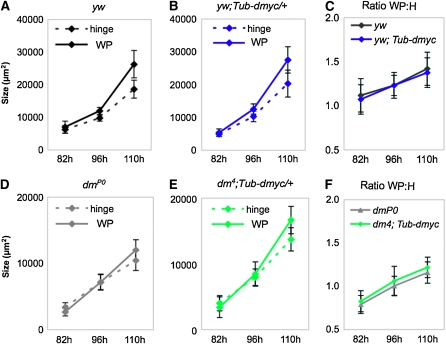Figure 4.—
Proportional growth in the wing disc does not require patterned expression of dMyc, but growth rate is reduced in its absence. Hinge and WP sizes throughout development in male larvae. (A) Our wild type strain, yw. (B) yw plus Tub-dmyc/+ wing discs (condition 1). (A and B) At 82 hr AEL, hinge and WP sizes do not differ in either yw or yw;Tub-dmyc/+ wing discs (hinge vs. WP 82 hr: yw, P = 0.18; yw;Tub-dmyc/+, P = 0.23), but are different at 96 and 110 hr for both genotypes (hinge vs. WP 96 hr: yw, P = 4.0 × 10−8; yw;Tub-dmyc/+, P = 2.2 × 10−4; hinge vs. WP 110 hr: yw, P = 2.2 × 10−7; yw;Tub-dmyc/+, P = 2.2 × 10−9). (C) Ratios of wing WP to hinge (WP:H) in control yw and yw;Tub-dmyc wing discs throughout development. WP:H significantly increases over time in both yw and yw;Tub-dmyc/+ wing discs (Mann–Whitney test—yw: 82 vs. 96 hr, P = 0.027; 96 vs. 110 hr, P = 5.0 × 10−4; yw;Tub-dmyc/+: 82 vs. 96 hr, P = 4.8 × 10−3; 96 vs. 110 hr, P = 8.0 × 10−3), but WP:H ratios of yw and yw;Tub-dmyc/+ wing discs are not different from each other at any time point (Mann–Whitney test—yw vs. yw;Tub-dmyc/+: 82 hr, P = 0.47; 96 hr, P = 0.91; 110 hr, P = 0.41). (D) dmP0 (condition 2). (E) dm4;Tub-dmyc/+ (condition 3). (D and E) At 82 hr, hinge and WP size are significantly different in dmP0 wing discs (P <10−3) but are not different in dm4;Tub-dmyc/+ wing discs (P = 0.27). At 96 hr AEL, hinge and WP size are not significantly different in either dmP0 or dm4;Tub-dmyc/+ wing discs (hinge vs.WP at 96 hr: dmP0, P = 0.99; dm4; Tub-dmyc/+, P = 0.26) but are different at 110 hr in both genotypes (hinge vs. WP at 110 hr: dmP0, P = 8.0 × 10−4; dm4; Tub-dmyc/+, P = 2.2 × 10−7). (F) Ratios of WP:H in dmP0 and dm4;Tub-dmyc/+ wing discs throughout development. WP:H ratios of dmP0 and dm4;Tub-dmyc/+ wing discs significantly increase over time (Mann–Whitney test—dmP0: 82 vs. 96 hr and 96 vs. 110 hr, P = 1.0 × 10−4; dm4;Tub-dmyc/+: 82 vs. 96 hr and 96 vs. 110 hr, P < 10−4) and were consistently smaller than wild type at every time point (Mann–Whitney test—yw v dmP0 at 82, 96, 110 hr: P <10−4; yw v dm4;Tub-dmyc/+ at 82 and 96 hr: P = 1.0 × 10−4 and at 110 hr: P = 2.0 × 10−4). WP:H ratios of dmP0 and dm4;Tub-dmyc/+ wing discs were not significantly different at any time point (Mann–Whitney test—dmP0 vs. dm4;Tub-dmyc/+ at 82 hr: P = 0.44; at 96 hr: P = 0.91; and at 110 hr: P = 0.41). Measurements were done with animals carrying a Tub-dmyc cassette on chromosome 2. All P-values are derived from Student's t-tests unless otherwise indicated. Error bars show standard deviation. Three additional experiments showed similar trends.

